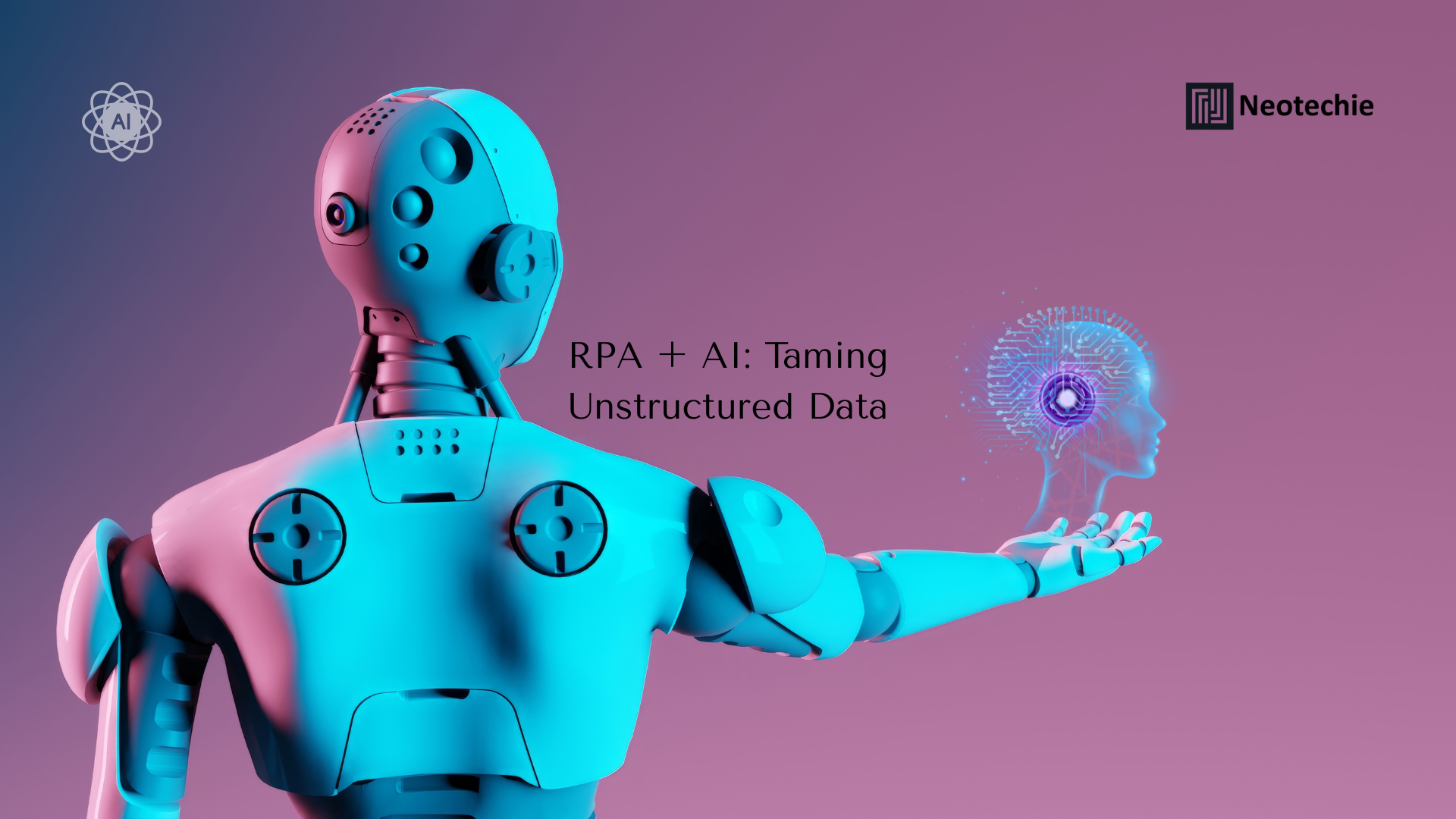How RPA and AI Complement Each Other to Handle Unstructured Data & Adaptive Decision-Making
Robotic Process Automation (RPA) has proven its value by automating structured, rule-based tasks at scale. Yet, many business processes extend beyond predictable rules. They involve emails, voice recordings, scanned documents, or decision-making scenarios where context matters. This is where Artificial Intelligence (AI) steps in. When combined with RPA, AI unlocks the ability to manage unstructured data and make adaptive, context-aware decisions. Together, RPA and AI form a powerful digital workforce that not only executes but also thinks, learns, and evolves.
What is the Synergy Between RPA and AI?
- RPA: Excels in automating repetitive, deterministic tasks such as data entry, report generation, or system integration. It thrives where rules are clear and processes are repeatable, creating efficiency and accuracy at scale.
- AI: Brings intelligence to automation through Natural Language Processing (NLP), Optical Character Recognition (OCR), Machine Learning (ML), and predictive analytics. It can understand language, recognize patterns, and even learn from data.
When integrated, AI enables RPA bots to process unstructured data, adapt workflows dynamically, and make decisions that mimic human judgment. This synergy transforms automation from a rules-based engine into a strategic enabler of complex operations.
Why Businesses Need RPA + AI
- Data Understanding: Businesses handle unstructured inputs like invoices, emails, or PDFs daily. AI converts these into usable formats, enabling RPA bots to process them with precision.
- Decision-Making: Unlike static rules, AI models analyze data contextually. For example, they can assess customer sentiment or evaluate risk before instructing bots on the next action.
- Scalability: RPA manages execution, while AI scales the types of processes automation can handle—from repetitive clerical work to decision-driven workflows.
- Customer-Centricity: With AI-enhanced automation, organizations offer smarter chatbots, personalized interactions, and faster resolutions, improving customer loyalty.
How the Integration Works
- Data Capture with AI
AI-powered tools such as OCR convert scanned documents into digital text, while NLP interprets the intent of emails or chat messages. This ensures no valuable data remains untapped. - Process Execution with RPA
Once data is structured, RPA bots carry out actions—updating records, triggering workflows, sending alerts, or processing transactions at scale with speed and accuracy. - Adaptive Decisions with Machine Learning
ML models allow bots to go beyond execution. They decide when to escalate, approve, or personalize based on historical data and predictive insights. - Continuous Improvement
AI feedback loops refine performance over time. The more data bots process, the smarter and more effective they become.
Business Transformation Through RPA + AI
- End-to-End Automation
Businesses no longer stop at automating fragments of a process. Entire workflows—such as claims handling or customer onboarding—can be executed seamlessly, from input to resolution. - Intelligent Insights
AI-driven analytics embedded in RPA workflows provide real-time dashboards and insights, enabling leaders to make data-backed decisions instantly. - Personalized Customer Experiences
With AI, bots interpret customer intent, predict needs, and respond empathetically. This elevates support interactions, building stronger brand relationships. - Faster Time-to-Market
Automation removes delays in compliance reporting, product launches, and service updates. Businesses innovate and deliver ahead of competitors. - Workforce Evolution
Employees shift from repetitive work to strategic initiatives. Freed from manual burdens, teams can innovate, collaborate, and focus on value creation.
Practical Use Cases of RPA + AI
- Finance: OCR reads loan applications, ML evaluates credit risk, and RPA completes approvals and notifications.
- Healthcare: NLP extracts patient data from medical notes, while RPA updates electronic health records automatically.
- Retail: Sentiment analysis uncovers customer feedback trends, and bots adjust inventory or recommend products accordingly.
- Customer Service: Intelligent chatbots combine NLP and RPA to resolve queries, escalate tickets, and improve satisfaction rates.
- Supply Chain: AI forecasts demand accurately, while RPA executes timely order management and logistics updates.
The What, Why, and How of RPA + AI
- What: A fusion of deterministic RPA with cognitive AI to automate both structured and unstructured processes end-to-end.
- Why: To handle complexity, context, and unpredictability in business operations while driving efficiency, accuracy, and adaptability.
- How: By integrating AI technologies like NLP, OCR, and ML into RPA workflows, businesses create a digital workforce that executes, learns, and continuously adapts.
Neotechie’s Role in Delivering RPA + AI Solutions
At Neotechie, we help organizations move beyond basic automation to embrace intelligent automation that drives measurable business outcomes. Our offerings include:
- Process Assessment & Discovery: Identifying processes where AI can augment RPA for maximum transformation.
- Custom AI-Enhanced Bots: Designing bots integrated with NLP, OCR, and ML to handle complex workflows.
- Cognitive Automation Deployment: Building solutions that process unstructured data and adapt to dynamic scenarios.
- Continuous Optimization: Monitoring and fine-tuning AI models and RPA workflows to evolve with business needs.
- Industry-Specific Solutions: Tailoring intelligent automation for finance, healthcare, retail, manufacturing, and customer service.
By partnering with Neotechie, businesses gain a competitive advantage by harnessing the combined power of RPA and AI. Our solutions accelerate efficiency, unlock adaptive decision-making, and transform how organizations operate.
Final Word
The integration of RPA and AI represents the next frontier in automation. It empowers organizations to manage unstructured data, respond intelligently to complex scenarios, and scale automation into new dimensions. With Neotechie’s expertise in intelligent automation, businesses can turn automation into a transformative force, driving resilience, agility, and sustainable growth.

